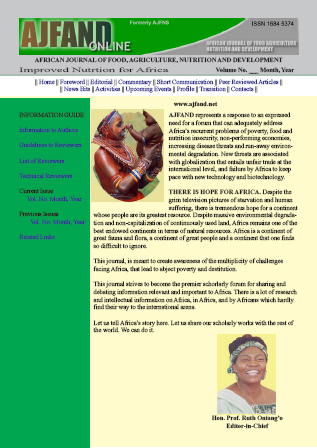
|
African Journal of Food, Agriculture, Nutrition and Development
Rural Outreach Program
ISSN: 1684-5358
EISSN: 1684-5358
Vol. 17, No. 4, 2017, pp. 12745-12757
|
 Bioline Code: nd17092
Bioline Code: nd17092
Full paper language: English
Document type: Review Article
Document available free of charge
|
|
|
African Journal of Food, Agriculture, Nutrition and Development, Vol. 17, No. 4, 2017, pp. 12745-12757
| en |
CULTIVATION AND USES OF STEVIA ( Stevia rebaudiana  Bertoni): A REVIEW Bertoni): A REVIEW
Hossain, MF; Islam, MT; Islam, MA & Akhtar, S
Abstract
Stevia [Stevia rebaudiana Bertoni; Family Asteraceae] is a natural sweetener plant that is
grown commercially in many parts of Brazil, Paraguay, Central America, Thailand, Korea,
China and India. The leaves of stevia are the source of sweet glycosides. It is mainly used as
a sweetener and flavor enhancer in the food and beverage industry. The chemical compound
obtained from stevia is considered to be the best alternative source of sugar especially for
diabetes patients. Climatic factors and agronomical practices affect the quality and quantity
of yield. The concentration of stevioside in the leaves is higher when the stevia plants are
grown under long days and when these plants are harvested just prior to flowering. Time of
harvesting depends on land type, type of stevia and growing season. The first harvest can be
done four months after planting and subsequent harvest once after every 3 months. Such
medicinal plants are becoming fairly popular for the treatment of different diseases all over
the world. It could be suitable for diabetic and obese persons. It also showed antibacterial,
antiseptic, anti-inflammatory, anti-fertility, hypotensive, diuretic and cardiotonic properties.
Stevia is a small perennial shrub that has been used for centuries as a bio-sweetener and for
other medicinal purposes. In addition, alternative sweeteners offer another benefit in
maintaining good dental health. S. rebaudiana sweeteners are used sparingly and there seems
to be no threat to public health. Stevia has been introduced to the Kenyan market as one of
the cash crops for agro-based industry. The changes in leaf yield and accumulation of
stevioside in response to different environmental conditions and nutritional variations might
provide some leads to develop strategies for increasing the productivity of the stevia. Quality
of the stevia product depends on drying temperature; high temperatures negatively affect
quality, diminishing medicinal and commercial value. Multiple global regulatory
organizations have determined that consumption of high quality stevia products within
recommended doses is safe for all.
Keywords
Stevia; Cultivation; Medicinal uses; Diabetes; Natural sweetener; Flavor enhancer; Glycosides
|
| |
© Copyright 2016 - African Journal of Food, Agriculture, Nutrition and Development
Alternative site location: http://www.ajfand.net/
|
|
